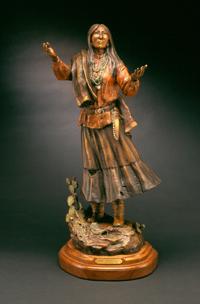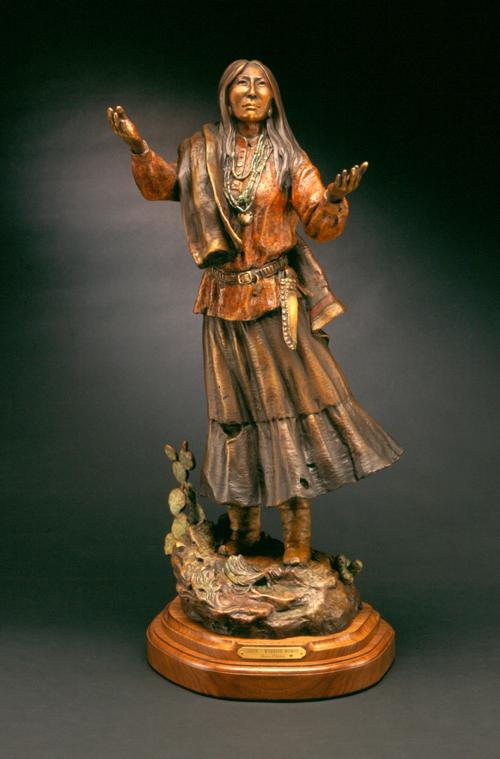Chihenne Apache Lozen was born sometime around the mid-1840s and probably grew up in New Mexico Territory in an area known as Warm Springs, or Ojo Caliente.
As a child, Lozen’s athletic abilities outshone most of her peers. By the age of 20, she was an expert at stealing horses.
She acquired an adept knowledge of herbs and plants and often ministered to the injured and sick.
She also could detect enemies from great distances. With her arms outstretched, palms up, she would turn to follow the sun while she prayed to Ussen, the Apache Creator of Life. When she felt a tingling in her hands and her palms darkened, she knew from which direction the enemy would come.
Her brother, Chief Victorio, called Lozen his “right hand, strong as a man, braver than most, and cunning in strategy. Lozen is a shield to her people.”
Because of her skills and mystical talents, she often sat beside Victorio at council meetings and participated in warrior ceremonies. Few Apache women reached the status Lozen experienced.
By the early 1860s, hostilities between settlers and the Apaches negated any chance of a peaceful settlement.
To retaliate for the injustices inflicted upon his people, Victorio led his band across the Southwest ransacking encroaching settlements.
But by 1870, the military had forced the Chihenne off their land, driving them onto reservations.
In 1877, they were herded onto the San Carlos Reservation, a desolate, unhealthy spot in Southeast Arizona known as “Hell’s 40 acres.”
Bristling under the strict reservation rules imposed on his people, Victorio led 300 Chihenne as they escaped from San Carlos. Lozen led the women and children back to Warm Springs.
A young Apache boy, James Kaywaykla, watched Lozen as she guided her people across a flooded river. Throughout his life, he remembered the stalwart woman who fought beside Chief Victorio trying to preserve their land.
James’ descriptions of Lozen’s acts of bravery, her wisdom as a scout, and her accomplishments as a medicine woman are one of the only firsthand accounts of her life.
“I saw a magnificent woman on a beautiful black horse,” James later wrote. “Lozen, sister of Victorio. Lozen, the woman warrior! High above her head she held her rifle. There was a glitter as her right foot lifted and struck the shoulder of her horse. He reared, then plunged into the torrent. She turned his head upstream, and he began swimming.”
Two years later, the Chihenne were again ousted from Warm Springs, this time sent to New Mexico’s Mescalero Reservation. When rumors circulated Victorio was targeted for arrest, his band, including Lozen, fled.
Battles between the military and Chihenne took a devastating toll on both sides. In early 1880, the Apaches were eluding soldiers by staying south of the Rio Grande in Mexico, but their ammunition was running low.
Lozen agreed to make the long trip back to the Mescalero Reservation and return with more ammunition as well as additional warriors. Since she always felt it her duty to protect the women and children of the tribe, she agreed to take with her a young pregnant woman who wanted to return to the reservation.
Shortly after departing, Lozen hid the woman in a wash and stood guard as soldiers passed by and the young woman silently gave birth. As soon as mother and child could travel, the trio headed out carrying only a three-day supply of food.
As the women followed the Rio Grande, Lozen watched as a herd of cattle entered the riverbed. Using only a knife, she killed one of the cows, a feat even a strong man would hesitate to undertake. The meat gave them a few more days of nourishment.
Water, however, became a bigger issue. To quench their thirst, they crushed nopal pads for the little water they held.
Lozen also killed a calf and used its stomach for a makeshift canteen but it held only a small supply. When they came upon a lone soldier, Lozen quickly divested him of his rifle, ammunition, a blanket and his life. But most treasured was his canteen.
Finally arriving at the Mescalero Reservation, Lozen learned that on Oct. 14, 1880, Victorio and 78 of his followers were killed during a battle in the Tres Castillos Mountains.
Revenge for Victorio’s death consumed the Chihenne. Lozen joined the few remaining forces, raiding and killing across New Mexico and Arizona Territories.
The small band joined forces with the Chiricahua Apache Geronimo. “We were reckless of our lives,” Geronimo said, “because we felt every man’s hand was against us.”
In Geronimo’s camp, Lozen met Dahteste, a young Chiricahua woman. Since Dahteste spoke English, Geronimo enlisted the two women to take messages to military personnel as he bartered for the surrender of his people.
On Sept. 3, 1886, with provisions and ammunition depleted, Geronimo surrendered to Gen. Nelson A. Miles.
Lozen and Dahteste were with him along with a handful of men, women, and children. They boarded a train in Bowie, Arizona, that took them to Fort Marion, Florida.
The following year, the Apaches were relocated to Mt. Vernon Barracks north of Mobile, Alabama. Unused to the humid, swampy southern land, many died from illnesses such as diphtheria and tuberculosis.
Lozen lasted less than three years. On June 17, 1889, she died from tuberculosis and is buried in Alabama in an unmarked grave.





